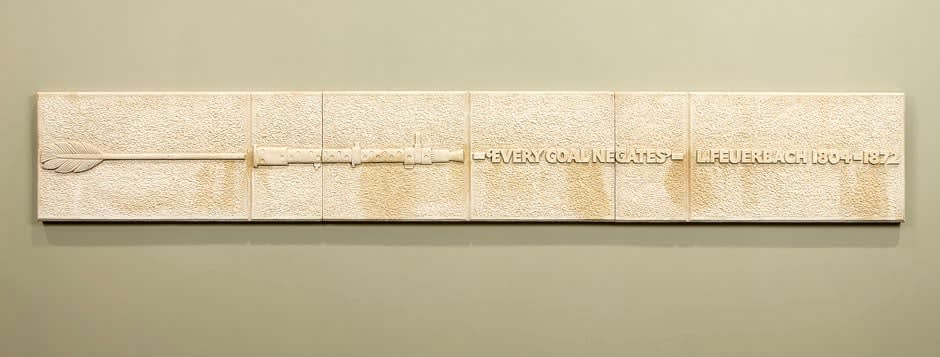-
Artworks

Ian Hamilton Finlay
Every Goal Negates (L. Feuerbach), with John Andrew, 1987stone16 1/8 x 106 1/4 x 1 1/8 in (41 x 270 x 3 cm)The quote is taken from Ludwig Andreas Feuerbach’s Gedanken über Tod und Unsterblichkeit (Thoughts on Death and Immortality), 1830. A German Romantic philosopher, Feuerbach argued against the personal, or individual,...The quote is taken from Ludwig Andreas Feuerbach’s Gedanken über Tod und Unsterblichkeit (Thoughts on Death and Immortality), 1830. A German Romantic philosopher, Feuerbach argued against the personal, or individual, immortality promised by Christianity for a belief in the re-absorption of the Spirit – the divine spark within each man and woman – into Nature as the fathomless sum of human understanding and moral law. Nature is the great Romantic textbook from which man learns his highest purposes, his greatest capacities. Yet nature as a raw physical phenomenon must, in imagination, be radically transformed – “destroyed” – for these purposes to be ultimately realized. In thought, we (god-like) make a tree into a type of all trees, a field into an Idea of all fields. More fully, Feuerbach stated: “These activities [of daily existence] become nothing to me for themselves; they are only means for the attainment of a goal that lies far beyond them. Every goal negates; where there is no destruction, no negation and sacrifice of independent existence, there is no purpose. Purpose is Spirit, but Spirit is the death, the destroyer, of sensible reality….” In Finlay’s piece, which is arranged as a progression from left to right, the feathered shaft of an antique arrow is re-placed, or superseded, by the barrel of a modern machine gun. From the gun’s mouth issue – emphatically spit – the words, “EVERY GOAL NEGATES,” asserting that the recovery of an Ideality (the “GOAL”) occurs only through the “negation,” or obliteration, of the material and materialist world we have come so resolutely, so complacently to inhabit. The arrow is first and foremost an attribute of Apollo, the Classical Greek god not only of archery, poetry and music but also of the “sun,” i.e., of enlightenment, radiant truth and the Ideal. The attribute of an Apollo updated is, however, the machine gun. The feathered arrow shaft also makes a sidelong allusion to Zeno, one of the pre-Socratic philosophers Finlay’s art occasionally engages, and to “Zeno’s Paradox.” The flying arrow “logically,” if not practically, is motionless; the Golden Age, though past and unquestionably mythical, is always latently present to a powerful imagination; and our inborn logic, while hopelessly flawed by empirical standards, is beautifully attuned to the eternal Ideal.Exhibitions
Ian Hamilton Finlay: Camouflage, David Nolan Gallery, New York (November 4 – December 4, 2009)
MAILING LIST SIGN-UP
By completing this form, you confirm that you would like to subscribe to DAVID NOLAN’s mailing list and receive information about exhibitions and upcoming events. Your email address will be used exclusively for the mailing list service.
* denotes required fields
We will process the personal data you have supplied to communicate with you in accordance with our Privacy Policy. You can unsubscribe or change your preferences at any time by clicking the link in our emails.

